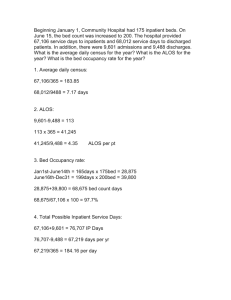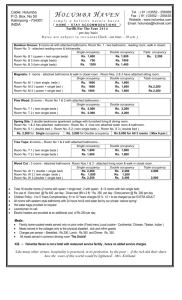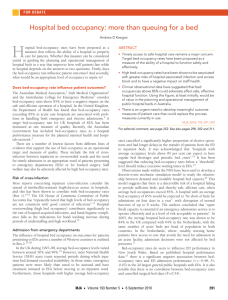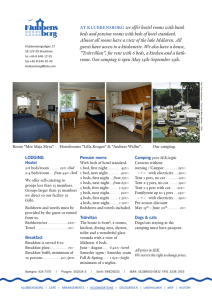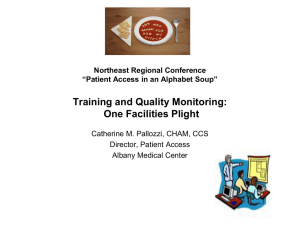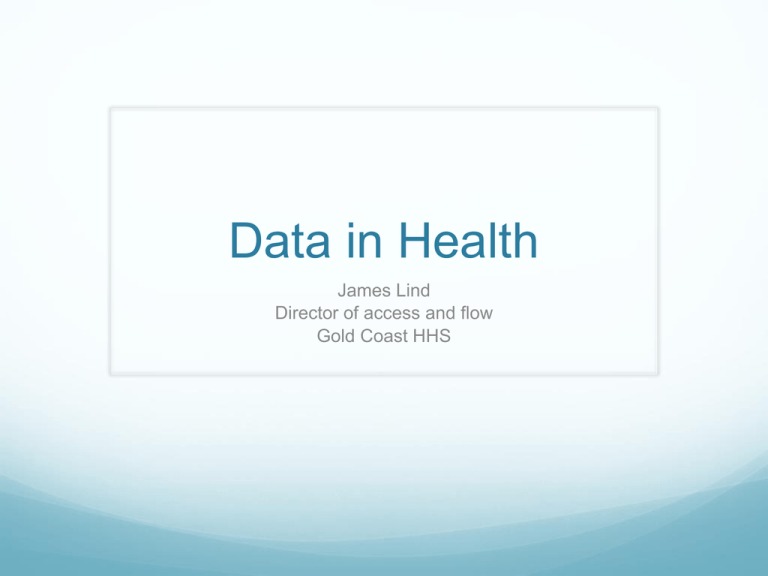
Data in Health
James Lind
Director of access and flow
Gold Coast HHS
System flow why bother?
All hospital are uniquely similar!!
90
Inpatient Admissions (patients/hr) (Y1 axis)
Inpatient Discharges (patients/hr) (Y1 axis)
ED Presentations (patients/hr) (Y1 axis)
ED Discharges (patients/hr) (Y1 axis)
Inpatient Admissions from ED (patients/hr) (Y1 axis)
Inpatient Length of Stay (days) (Y2 axis)
ED Length of Stay (inpatients) (hours) (Y2 axis)
ED Length of Stay (others) (hours) (Y2 axis)
ED Access Block Cases (inpatients) (patients/hr) (Y2 axis)
Every hospital is uniquely
45
90
GROUP 2
GROUP 1
80
45
Beds > 900
Similar!!!
40
80
35
70
90
GROUP 3
C
900 >= Beds > 300
45
40
80
35
70
300 >= Beds
40
C
70
60
50
25
50
25
20
40
20
40
20
30
15
30
15
30
15
20
10
20
10
20
10
10
5
10
5
10
5
0
0
0
0
0
0
30
115%
110%
105%
100%
OCCUPANCY
95%
90%
85%
80%
A
75%
110%
105%
100%
OCCUPANCY
95%
95%
100%
OCCUPANCY
90%
85%
80%
75%
Mathematic
A
90%
40
50
A
85%
25
B
30
80%
60
75%
30
70%
60
B
85% occupancy
is inefficient B
35
C
Annual Patient Flow is predictable
Key is visualisation
105
450
100
400
95
350
90
85
80
300
1 Hour Early
Actual
250
1 Hour Late
2 Hours Late
200
75
150
70
100
65
50
60
55
0
0 1 2 3 4 5 6 7 8 9 10 11 12 13 14 15 16 17 18 19 20 21 22 23
Time of Day (hour)
Discharges/hour
Occupancy (%)
2 Hours Early
Visualization of data
Discharge 30%
by 11am!!!
300
6
ED Length of Stay (2009-2011)
Age (2009-2011)
All Arrivals
Ambulance Arrivals
Walked In Arrivals
5
200
16 Yr Olds
17 Yr Olds
Number of Presentations
250
Number of Presentations
250
Arrival Mode (2009-2011)
200
150
100
Number of Presentations
350
18 Yr Olds
150
19 Year Olds
100
4
3
Avg LOS (hours)
2
50
1
50
0
0
1
3
5
7
9 11 13 15 17 19 21 23 25 27 29 31 33 35 37 39 41 43 45 47 49 51
0
1
3
5
7
9 11 13 15 17 19 21 23 25 27 29 31 33 35 37 39 41 43 45 47 49 51
Week of Year
180
3
5
7
9 11 13 15 17 19 21 23 25 27 29 31 33 35 37 39 41 43 45 47 49 51
160
Sex (2009-2011)
Week of Year
70
Triage Category (2009-2011)
Primary ICD (2009-2011)
Females
160
140
60
T1
T3
T5
120
Number of Presentations
120
100
80
60
T2
T4
Z53.2
S61.9
S93.40
J45.9
J03.9
S13.4
S80.81
Z04.3
Z48.0
R21
50
Number of Presentations
Males
140
Number of Presentations
1
Week of Year
100
80
60
40
30
F10.0
S91.7
S90.81
S93.6
X84
S01.88
F43.9
S93.5
T00.9
N39.0
S00.9
S90.84
S62.2
S63.7
R22.9
S00.8
T50.9
R10.3
T00.2
R55
20
40
40
10
20
20
0
0
1
3
5
7
9 11 13 15 17 19 21 23 25 27 29 31 33 35 37 39 41 43 45 47 49 51
Week of Year
0
1
3
5
7
9 11 13 15 17 19 21 23 25 27 29 31 33 35 37 39 41 43 45 47 49 51
Week of Year
1
3
5
7
9 11 13 15 17 19 21 23 25 27 29 31 33 35 37 39 41 43 45 47 49 51
Week of Year
Does it work? District NEAT Time Line
Solutions informed by data
Appointment
of new CE
Executive
rounding in
ED
Full time
BPIO
appointed
Macro NEAT Project
Process
People
Access and
Flow Unit
commence
s
Access and
flow
director
appointed
Business
Practice
Improvement
officer role
commenced
BPIO
commenced full
time Robina
and Southport
ED
Rapid
access
clinics for
medicine
commence
d
Redeployment
of medical
staff to clinics
•Slack box process redesign
•Early decision making
•Education to staff on NEAT
•Performance feed back
•Definition on purpose and function of ED
Ward
based
porterage
and
refinement
of bed
cleaning
Redesign
of bed
manage
ment
Additional nursing
resources for bed
management
24 hour CNC
coverage 5
days a week
PIT model
commence
d at
Southport
Emergency
Current
management
CNC to work
on floor to
increase
coverage
Restructure
of staffing to
accommodat
e early
decision
making in ED
• Reconfigure bed meeting
•* Additional Afternoon bed meeting
•Rescheduling of ICU radiology , cardiac
and HODU PT
•Opening of additional HDU over winter
Increase in
Short Stay
Unit
capacity
from 10
beds to 6
beds and 7
chairs
Reconfigure
of current
FTE to
accommodat
e new model
of care
Medical
Assessmen
t Unit
opens
Southport
Extra FTE
in medical,
nursing and
admin
Refinement
of ward
based care
model
New process in
bed
management
ADON
patient flow
and extra
bed
managers
Surge plans for
all subspecialities and
new Capacity
alert process
Key messages
Data informs but is a tool
Interpretation of data is key
How much error are you prepared to live with
Visualisation and translation of data is key

